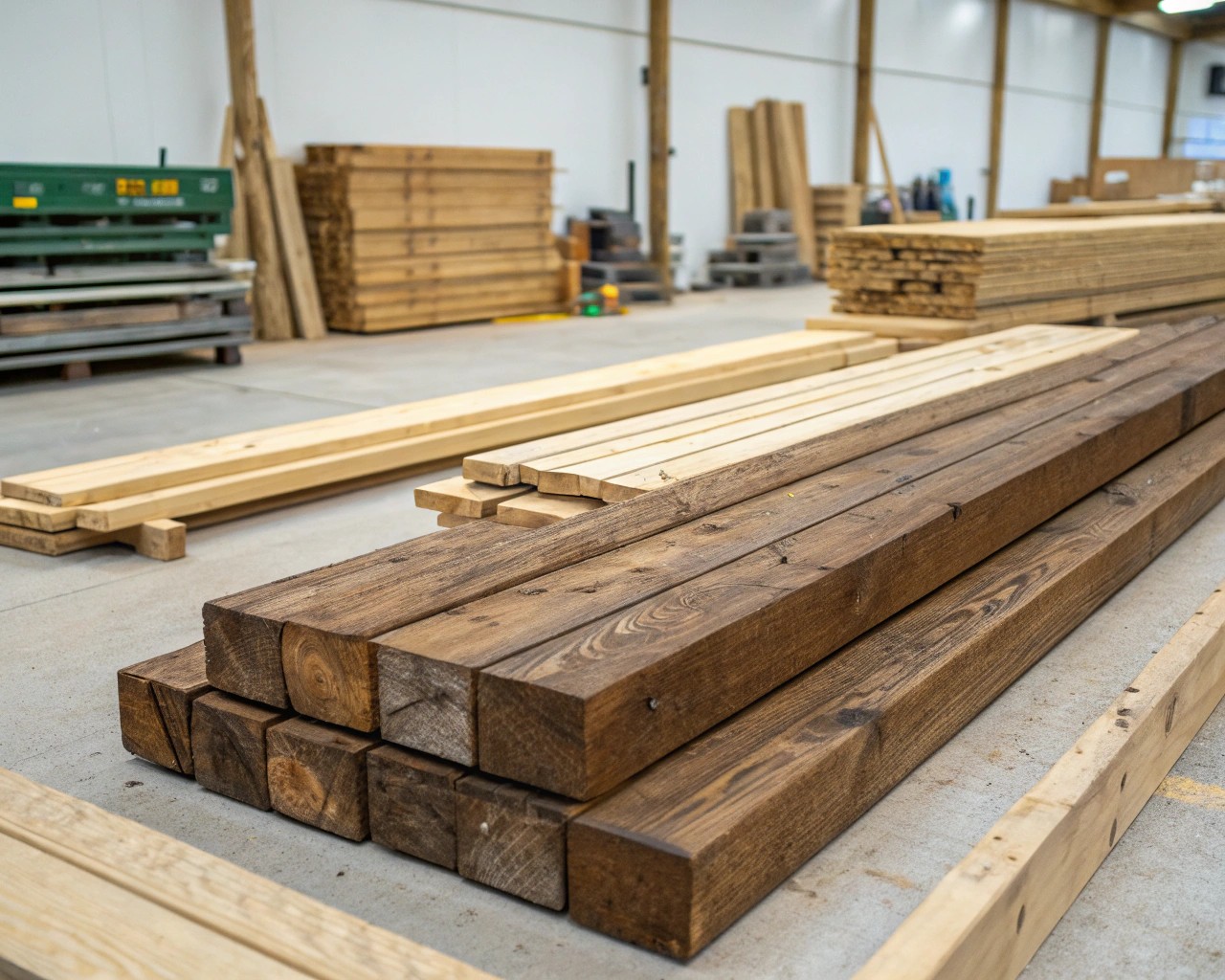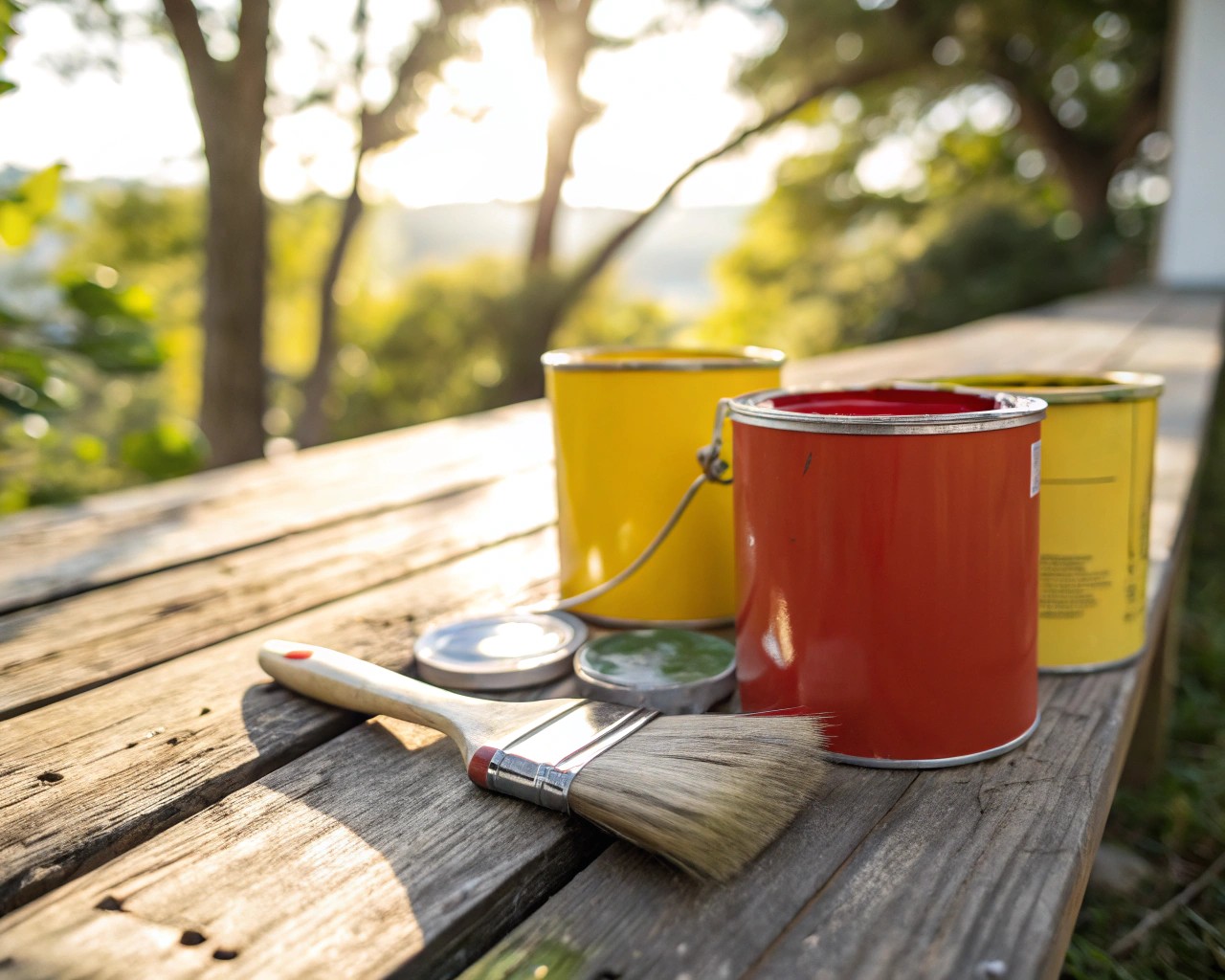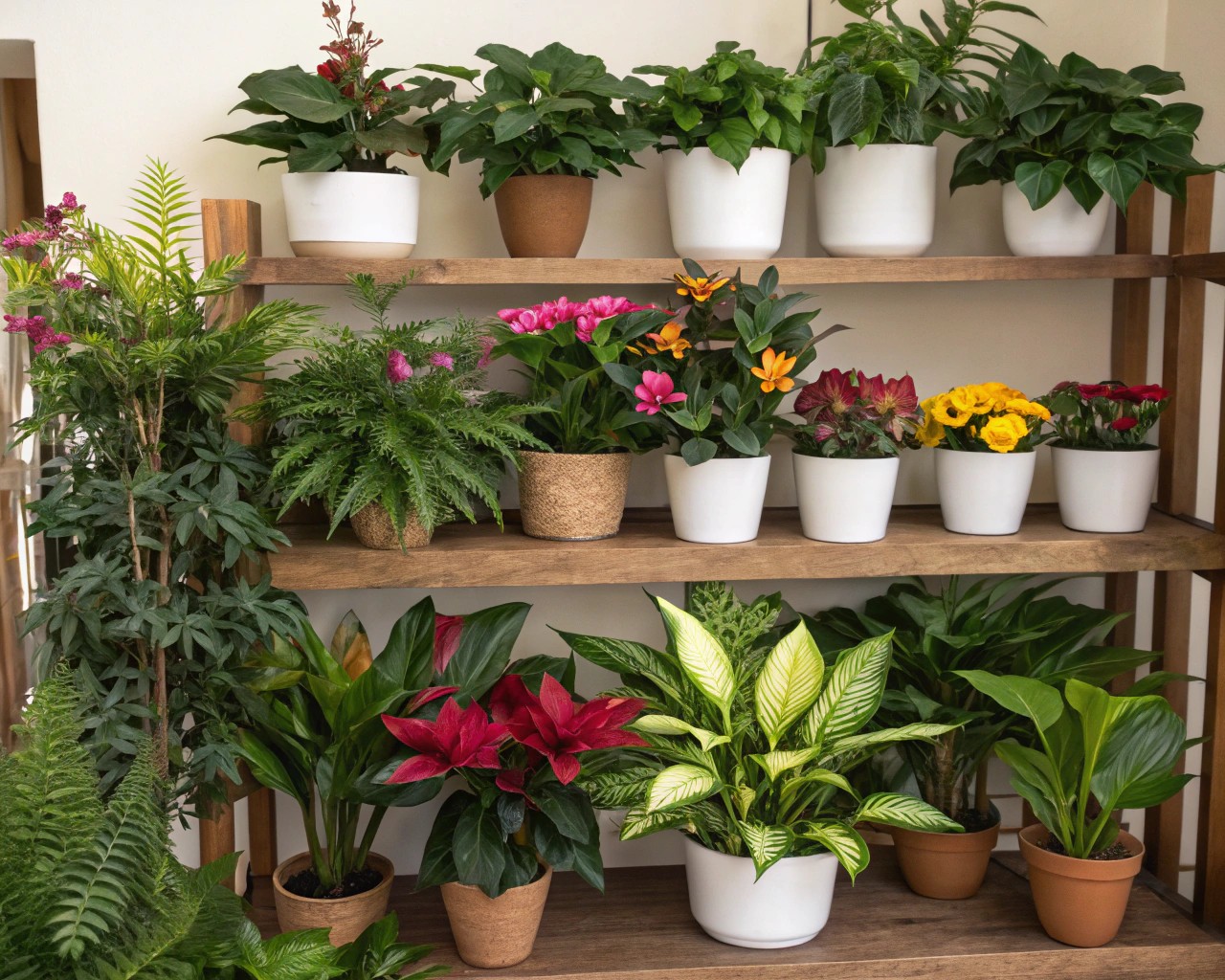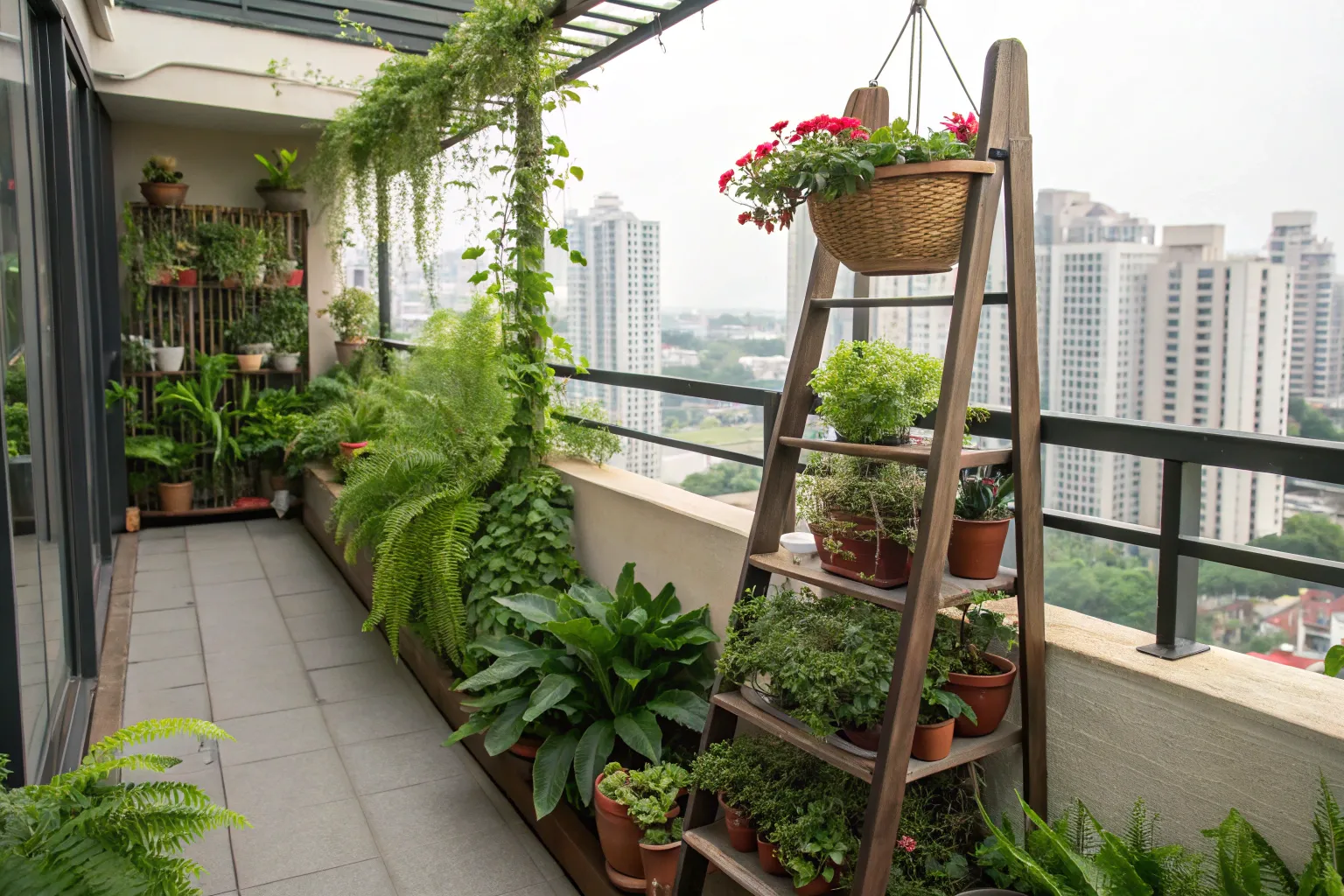Transform a simple step ladder into a stunning vertical garden solution that maximizes your balcony space while creating an eye-catching display for your plants. This project combines the rustic charm of repurposed materials with the practical benefits of vertical gardening, perfect for urban dwellers seeking to bring more greenery into their limited outdoor spaces.
Why Choose a Ladder Plant Shelf

Space Efficiency Meets Style
A ladder plant shelf offers maximum growing space within a minimal footprint—ideal for balconies where every square inch matters. Unlike traditional shelving that extends outward, this vertical approach utilizes height rather than floor space, leaving room for seating and movement. The triangular A-frame design provides inherent stability while creating multiple levels for plants of varying heights and light requirements.
Flexibility and Customization
The beauty of this project lies in its adaptability. You can adjust shelf depths to accommodate different pot sizes, modify heights between levels, and customize the finish to complement your balcony’s aesthetic. Whether you prefer a weathered farmhouse look or a crisp modern appearance, painted planks offer endless design possibilities.
Materials and Tools Overview
Essential Materials

For a standard 6-foot tall ladder shelf, you’ll need:
- One wooden step ladder (4-6 feet recommended) or materials to build ladder frame
- Cedar, pine, or pressure-treated lumber planks (1×6 or 1×8 boards work well)
- Exterior wood screws (2½-inch and 1¼-inch lengths)
- Wood glue designed for outdoor use
- Sandpaper (120 and 220 grit)
- Exterior primer and paint or wood stain
- Protective wood finish (polyurethane or marine varnish)
Required Tools
- Measuring tape and pencil
- Circular saw or miter saw
- Drill with bits
- Level
- Clamps
- Brush or roller for finishing
Safety Equipment
- Safety glasses
- Dust mask
- Work gloves
- Hearing protection
Planning Your Design
Determining Shelf Dimensions
I always start by measuring the step ladder’s width at each level where shelves will be installed. Step ladders naturally taper, so each shelf will be progressively shorter as you move upward. This creates an attractive graduated appearance while ensuring structural integrity.
For optimal plant display, plan shelf depths between 8-12 inches. Deeper shelves accommodate larger pots but add weight and visual bulk. Consider your plant collection’s needs—trailing plants benefit from deeper shelves, while compact herbs thrive on narrower ones.
Weight Distribution Considerations
The ladder’s A-frame design distributes weight effectively, but consider plant placement carefully. Position heavier pots toward the bottom and center of each shelf. This creates a stable foundation while preventing the structure from becoming top-heavy.
Step-by-Step Construction
Preparing the Ladder Frame
Assessment and Reinforcement
Begin by thoroughly inspecting your ladder for structural soundness. Look for loose joints, cracked rungs, or signs of rot in wooden ladders. Tighten all hardware and replace any damaged components before proceeding.
If building a ladder frame from scratch, cut four legs from 2×4 lumber, creating matching angles on each end—typically 15-20 degrees works well for stability. The angle determines how much the ladder leans; steeper angles provide more stability but require more floor space.
Creating Shelf Supports
Measure and cut horizontal supports from 2×2 lumber. These cross-braces will hold your plank shelves and should be cut to fit snugly between the ladder legs at your desired shelf locations. I typically space shelves 12-16 inches apart vertically, allowing adequate room for plant growth while maximizing display space.
Crafting the Shelf Planks
Measuring and Cutting
Measure each shelf location carefully, as the tapered ladder design means each shelf will be slightly different in width. Cut planks approximately 1 inch longer than the interior measurement to ensure proper overhang and visual balance.
For enhanced durability, consider creating tongue-and-groove joints where multiple boards join to form wider shelves. This technique prevents gaps from forming as wood expands and contracts with weather changes.
Edge Treatment and Finishing
Sand all plank surfaces, starting with 120-grit paper to remove roughness, then finishing with 220-grit for smoothness. Pay special attention to edges and ends, which are most vulnerable to moisture penetration.
Round over sharp edges slightly using sandpaper or a router with a small roundover bit. This detail adds a professional appearance while preventing splintering that could damage plants or hands during maintenance.
Assembly Process
Dry Fitting
Before final assembly, test-fit all components to ensure proper alignment and fit. This step prevents problems during glue-up when working time is limited. Mark shelf positions on the ladder legs using a pencil and level to ensure shelves install straight and level.
Securing Shelf Supports
Apply exterior wood glue to contact surfaces, then secure shelf supports to ladder legs using 2½-inch exterior screws. Pre-drill holes to prevent splitting, especially near board ends. Ensure supports are perfectly level—this foundation determines the final shelf alignment.
Installing Shelf Planks
Position planks on the installed supports, checking for level and proper overhang. Secure from underneath using 1¼-inch screws driven up through the supports into the planks. This method hides fasteners while providing strong attachment.
For wider shelves requiring multiple boards, ensure joints fall over supports for maximum strength. Apply wood glue between boards before final installation to create a unified surface.
Finishing for Weather Protection
Surface Preparation
Proper surface preparation determines finish longevity and appearance. Fill any screw holes or imperfections with exterior wood filler, then sand smooth once dry. Clean all surfaces thoroughly to remove dust and debris before applying finish.
Primer Application
Apply high-quality exterior primer to all surfaces, paying special attention to end grain and joints where moisture penetration is most likely. Primer creates a uniform base for paint while enhancing adhesion and coverage.
Paint Selection and Application

Choose exterior acrylic paint formulated for wood surfaces and high-moisture environments. Semi-gloss or gloss finishes offer superior durability and easier cleaning compared to flat paints. For balconies with limited sun protection, consider lighter colors to reflect heat and prevent premature fading.
Apply paint in thin, even coats using a high-quality brush or roller. Two coats typically provide adequate coverage and protection, but three coats offer enhanced durability in harsh climates.
Protective Topcoat
For maximum weather protection, apply a clear marine-grade polyurethane or exterior varnish over the painted surface. This additional layer shields the paint from UV damage while providing water resistance. Choose products specifically designed for outdoor use and marine applications for best results.
Placement and Installation
Balcony Positioning
Consider sun patterns, wind exposure, and weight distribution when positioning your ladder shelf. Most plants benefit from morning sun with afternoon shade, especially in hot climates. Position the shelf to take advantage of natural light patterns while protecting plants from harsh afternoon sun.
Ensure adequate clearance around the shelf for plant maintenance and watering. Leave at least 18 inches between the shelf and balcony railings or walls to allow air circulation and prevent moisture buildup.
Anchoring Options
While the A-frame design provides inherent stability, consider additional anchoring for safety, especially in windy locations or when fully loaded with plants. Small L-brackets can secure the top shelf to a wall, while furniture pads under the feet prevent scratching and sliding.
Weight Considerations
Remember that soil, water, and ceramic pots add significant weight. A fully planted ladder shelf can weigh 100 pounds or more. Verify your balcony’s weight capacity and distribute loads evenly across the structure.
Plant Selection and Arrangement

Choosing Appropriate Plants
Select plants based on your balcony’s light conditions, climate zone, and maintenance preferences. Compact varieties work best, as they won’t overwhelm the shelf structure or require frequent pruning.
Top Shelf Recommendations
– Trailing plants like pothos or string of pearls
– Small flowering annuals
– Compact herbs
Middle Shelves
– Medium-sized foliage plants
– Seasonal vegetables in containers
– Ornamental grasses
Bottom Shelf
– Larger specimen plants
– Plants requiring consistent moisture
– Storage containers for tools and supplies
Arrangement Principles
Create visual interest by varying plant heights, textures, and colors across the shelf levels. Place taller plants toward the back of each shelf with shorter ones in front, creating depth and ensuring all plants receive adequate light.
Consider seasonal rotation—use the upper shelves for plants requiring frequent attention during growing season, then move them to lower, more accessible shelves for winter storage if needed.
Maintenance and Care
Seasonal Inspection
Inspect your ladder shelf at least twice yearly, checking for loose fasteners, paint deterioration, or structural issues. Address problems promptly to prevent small issues from becoming major repairs.
Spring Preparation
– Tighten all hardware
– Touch up paint as needed
– Check drainage in plant containers
– Refresh protective coatings if showing wear
Fall Maintenance
– Remove dead plant material
– Clean shelf surfaces
– Apply additional protective coating if needed
– Consider plant winterization needs
Long-term Preservation
Wood exposed to outdoor conditions requires ongoing maintenance for optimal longevity. Plan to refresh paint every 2-3 years, or sooner if showing signs of wear. High-quality initial preparation and materials significantly extend maintenance intervals.
Monitor for signs of wood movement or checking, especially during the first year as lumber adjusts to local climate conditions. Minor cracks or gaps are normal but should be sealed to prevent moisture infiltration.
Troubleshooting Common Issues
Structural Concerns
If the shelf develops wobbling or instability, first check all fasteners for tightness. Wood naturally expands and contracts with moisture changes, potentially loosening connections over time. Retighten all screws and bolts, replacing any that have become stripped or damaged.
For persistent stability issues, consider adding diagonal bracing between ladder legs or installing additional shelf supports. These modifications enhance rigidity without significantly altering the original design aesthetic.
Drainage Problems
Poor drainage is the leading cause of both plant failure and shelf deterioration. Ensure all plant containers have adequate drainage holes and use saucers to protect wood surfaces from standing water.
If shelf surfaces show water staining despite using saucers, consider applying additional protective coating or upgrading to marine-grade finishes designed for constant moisture exposure.
Paint and Finish Issues
Peeling or fading paint not only looks unsightly but compromises wood protection. Address finish problems promptly by cleaning affected areas, light sanding, and spot-priming before repainting.
For best results, use the same paint system as the original application. Mixing different paint types or brands can lead to adhesion problems and uneven appearance.
Seasonal Adaptations
Summer Considerations
During peak growing season, your ladder shelf will likely be at maximum capacity. Monitor weight distribution and ensure adequate support as plants grow larger and heavier. Consider rotating plants periodically to prevent leaf burn on sun-exposed sides.
Hot weather increases watering frequency, which means more moisture exposure for the shelf structure. Check drainage systems regularly and ensure adequate ventilation around the shelf to prevent humidity buildup.
Winter Protection
In regions with freezing temperatures, consider seasonal modifications to protect both plants and shelf structure. Empty containers that might crack from freezing, and consider applying additional protective coating before winter weather arrives.
Some gardeners disassemble shelves seasonally, storing planks indoors while leaving the ladder frame in place. This approach maximizes shelf longevity but requires more effort in spring setup.
This ladder plant shelf design offers years of gardening enjoyment while adding vertical interest to your balcony space. The combination of practical functionality and attractive appearance makes it an ideal solution for urban gardeners seeking to maximize their growing potential within limited space constraints.
Through careful material selection, proper construction techniques, and ongoing maintenance, your ladder shelf will provide a stable, attractive platform for countless seasons of balcony gardening success.

